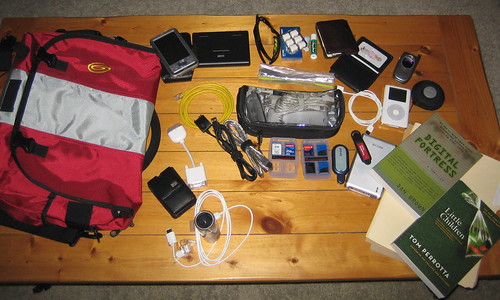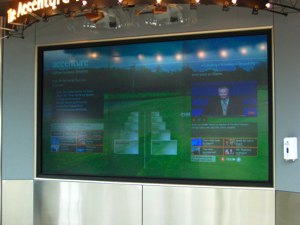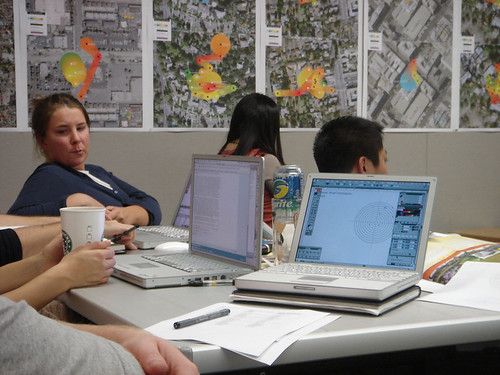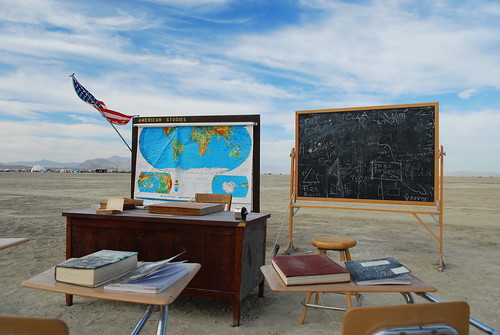Written yesterday at the airport
 |
|
|
I’ve been at home for just more than 24 hours. It was a good day — a fathers day. The kids gave me two seasons of The West Wing, including season 4, whose first episode, “20 Hours,” is the most YouTube’d WW of all seven seasons.
I spent the last couple of hours scanning through NECC blogs. It’s been fun and has helped me to find the spirit. It would be easy for me to say that I go to so many conferences that one more… But it’s not the case. NECC is huge — in just about every way you can imagine.
I’ve especially enjoyed the packing blogs. “What do I pack?” “Do I take my MacBook or the new Asus netbook.” “Which camera, my pocket Sony, or the cool dSLR I got for Christmas?”
The most interesting post was from the SL team at Discovery Educator Network. In NECC Prep Sessions a Big Hit, Lori Abrahams describes a series of recent sessions put on by DEN with reps from ISTE, including program chair, Anita McAnear. The purpose of the sessions was to provide some tips for people who will be attending the international edtech conference for the first time. Many conferences have sessions first thing, first morning, for newbies. But advancing this one to Second LifeTM makes a ton of sense.
Several people talked about sessions they will be conducting, including Harry G. Tuttle, who’ll be sharing ideas about assessing Web 2.0 tools. I have to confess that there’s a place on the back of my neck that always starts to itch when I see someone wanting to evaluate technologies. I can’t help but feel that as soon as you start applying rules, the tech stops being the Swiss Army Knife that it should be.
But Tuttle makes an excellent point in his post, Woeful Book Wiki Turned to Wow Book Wiki. As he has visited many school and classroom wikis, he has become increasingly discouragedl, as he notices that..
..most wikis are simply an online collection of student work. For example, all students in a class may do a book report and these book reports are posted to the class wiki. The students post their book report and the project is done when the last book report is posted. There has been no interaction among students or other adults. They have only worked in one learning style, linguistics. Likewise, the students have paraphrased (summarized) their book; they have not analyzed it. ((Tuttle, Harry G. “Woeful Book Wiki Turned to Wow Book Wiki.” [Weblog Education with Technology Harry
G. Tuttle] 20 Jun 2009. Web.21 Jun 2009. <http://eduwithtechn.wordpress.com/2009/06/20/woeful-book-wiki-turned-to-wow-book-wiki/>.))
Harry then describes a wonderful alternative that creatively expands the wiki from collection of ideas, to an idea collective. Read his blog post for the details.
Of course, this is not an uncommon situation. So many people come to these conferences looking for the tech de jour. Then they bring it home and integrate the life out of it.
It may be the way that we present the technology — like snake oil salesmen. I’m raising my hand.
Or perhaps it’s just what people come to the conference for — to discover and embrace the new cool thing.
I would like to suggest, for the coming conference, a moratorium on the phrase, “Integrate technology.” Don’t say it at NECC. Don’t even think it. I’ll have nanobots loose at the convention center floating on the breeze, listening for utterances the IT. If you say it, or think it, my nanobots will hone in and drain the electricity from your iPhone.
Enough of the fun. The answers we return from NECC with should not be, “This is the technology my students should be using.” The answer should be,
“Here’s how my students can learn that is more relevant to their future, their learning skills, and the information landscape on which we all live.”
I’ll see many of you there, for the few days I’ll be attending NECC.



 In 1967, my family (Dad, Mom, and we four boys) loaded into the Plymouth Belvedere wagon and drove up to Montreal Canada pulling a camping trailer — that my Dad built. We went to the 1967 International and Universal Exposition, or
In 1967, my family (Dad, Mom, and we four boys) loaded into the Plymouth Belvedere wagon and drove up to Montreal Canada pulling a camping trailer — that my Dad built. We went to the 1967 International and Universal Exposition, or 

 The graph on the left represents the responses, at this moment, based on my interpretations. Some tweets delivered more than one message, for instance, indicating a wish for 1:1, more computers, and netbooks, all in the same tweet. I found it interesting that only 5% of the messages seemed to directly or indirectly reference budget cuts. The rest are wishes I would have expected to see anytime. It is also noteworthy, the number of tweets that asked for administration and fellow staff who were more willing to try new things — innovate.
The graph on the left represents the responses, at this moment, based on my interpretations. Some tweets delivered more than one message, for instance, indicating a wish for 1:1, more computers, and netbooks, all in the same tweet. I found it interesting that only 5% of the messages seemed to directly or indirectly reference budget cuts. The rest are wishes I would have expected to see anytime. It is also noteworthy, the number of tweets that asked for administration and fellow staff who were more willing to try new things — innovate.


